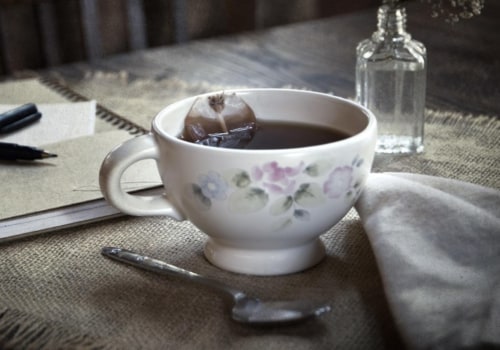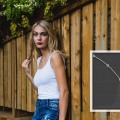Capturing creative abstract shots can be a great way to make your food photography stand out. Whether you are looking to shoot an artistic plate of food or a stunning landscape, abstract shots can make your images truly memorable. But how do you capture these unique angles? In this article, we'll look at how you can make the most of your camera and settings to get the perfect abstract shot.
Different Types of Angles
Wide-angle lenses are the most common lenses used to create unique abstract shots. They allow you to capture a wide field of view, which can be used to create dynamic compositions.Wide-angle lenses also allow you to get close to the subject and capture interesting details. Using a telephoto lens is another great way to capture unique abstract shots. Telephoto lenses allow you to capture details from a distance, making it easier to capture unique angles. They also provide a narrow field of view, which can be used to create interesting compositions.
Using a fisheye lens is also a great way to capture abstract shots with creative angles. Fisheye lenses provide an extremely wide field of view, which can be used to create interesting compositions. They also create a curved effect that can be used to add depth and texture to your shots. Using a tilt-shift lens is another great way to capture abstract shots with creative angles.
Tilt-shift lenses allow you to tilt the lens in different directions, which can be used to create unique compositions and capture details from different angles.
Tips for Shooting Abstract Shots
Abstract shots can be incredibly captivating and unique, but capturing them with the right angles and techniques can be tricky. Here are a few tips that can help you get the most out of your abstract shots:Use Backlighting: Backlighting can add a great deal of depth and contrast to your abstract shots. To achieve this effect, position your subject in front of a light source such as a window or lamp, and then adjust the angle until the light casts interesting shadows on your subject.Experiment With Shutter Speed: By experimenting with different shutter speeds, you can create abstract shots that have a sense of motion or dynamism. Set your camera to a slower shutter speed and then capture an action shot as your subject moves through the frame. This can create stunning abstract effects that are sure to make your photos stand out.
Focus On Details:
Don’t forget to focus on the details when shooting abstract shots. Look for interesting textures, colors, and shapes that can be used to add depth and complexity to your photos.Capturing the details in an abstract shot will help to create a more interesting composition.
Creating Motion with a Bird's Eye View
Bird's Eye View photography is a great way to create a sense of motion in an image. Shooting from above, you can capture the movement of people, vehicles, and objects, and bring life to your images. The view from above also adds a dramatic effect, as the details can be seen more clearly. By capturing an abstract shot from a bird's eye view, you can create an interesting composition that will draw the viewer in.When shooting from above, it's important to think about the angle of the shot. A slightly angled shot can add more visual interest, as well as a sense of movement. You can also use leading lines to create motion in the composition. If you want to capture an abstract shot with a strong sense of motion, try using a wide angle lens to capture as much of the scene as possible.
Shooting from a bird's eye view can also help you create a more dynamic composition. For example, if you are shooting a busy street scene from above, you can use the angles of the buildings and streets to create interesting shapes and patterns in your image. This technique can also be used for food photography composition, as you can use the angles of the food and plates to create an interesting layout. Capturing abstract shots with creative angles can be a great way to capture unique and interesting photos.
By using a bird's eye view and playing with angles, you can create dynamic compositions that will draw the viewer in.
Using Angle to Create Different Perspectives
Angles have a powerful effect on the composition of a photo and can create vastly different perspectives. By using angles, you can emphasize size, create drama, and create a sense of depth in your photos. For example, shooting from a high angle can emphasize the size of objects in the frame. This can be useful when shooting food dishes, as you can make them look larger and more impressive.On the other hand, shooting from a low angle can create a sense of drama and draw attention to certain elements in the frame. In addition to shooting from different angles, you can also experiment with the angles of objects in the frame. Tilting objects or lines in the frame can give your photos an interesting dynamic. This technique is especially effective for abstract shots, as it can add an extra layer of visual interest to your images.
Creating Motion with a Bird's Eye View
Shooting from a bird's eye view can be an incredibly effective way to create dynamic motion in an abstract shot.By shooting from a high angle, you can create the illusion of movement and flow within the image. This can be especially useful when capturing food photography compositions, as it can help to bring the image to life. Using different angles and perspectives can also help to emphasize certain elements of the shot. For example, a bird's eye view can help to draw the viewer’s attention to the foreground of the image, while a lower angle can help to highlight the background elements.
Experimenting with different angles can help to create a more interesting and compelling composition. When shooting from a bird's eye view, it is important to take into account the lines and curves of the subject matter. This will help to create a sense of motion within the image. Additionally, pay attention to how light and shadows interact with the composition. These elements will help to bring depth and dimension to the shot. Using a bird's eye view for abstract shots can be an incredibly powerful way to capture unique compositions.
By taking into account the lines and curves of the subject matter and paying attention to how light and shadows interact, you can create dynamic compositions that capture a sense of movement.
Dynamic Patterns with Tilt-Shift Lenses
Tilt-shift lenses are a great tool for creating dynamic patterns in your images. By adjusting the tilt and shift of the lens, you can manipulate the plane of focus to create unique shapes and lines in your photos. This technique is often used to create abstract shots with creative angles, giving you the ability to capture unique and interesting photos. When using tilt-shift lenses, you can adjust the tilt of the lens to create a wide range of shapes and lines. By tilting the lens, you can create diagonal lines or curved shapes in your image.You can also adjust the shift of the lens to move the plane of focus, creating an interesting 3D effect. By combining tilt and shift adjustments, you can create dynamic patterns in your photos. For example, you can use tilt-shift lenses to create abstract shots with creative angles. You can adjust the tilt of the lens to create curved lines or diagonal patterns in your image. You can also adjust the shift of the lens to move the plane of focus and create a 3D effect.
By combining tilt and shift adjustments, you can create unique and interesting shots that capture the attention of viewers. Using tilt-shift lenses to create dynamic patterns in your images can be a great way to add interest and depth to your food photography composition and other creative composition techniques. Experiment with different tilt and shift adjustments to create unique patterns in your photos, and have fun exploring all the possibilities that tilt-shift lenses offer!
Using Low Angles to Create Depth
Using low angles in photography can help emphasize depth in an image and create dynamic compositions. When shooting from a lower angle, you are able to capture more of the background of the subject, which helps to create a sense of distance and depth between the foreground and background elements. Additionally, shooting from a low angle can also make your subject appear larger than life, adding drama and impact to your composition. Low angles can be used in a variety of creative ways.You can use them to capture unique perspectives, or to exaggerate the size of an object. For example, if you are shooting a landscape photo, a low angle can help emphasize the vastness of the landscape. Similarly, if you are shooting a portrait of a person, a low angle will make them appear larger than life. When using a low angle for your abstract shots, keep in mind that this technique will work best when combined with other elements. For example, if you are shooting an abstract shot of a tree from a low angle, you may want to include other elements such as plants or rocks in the foreground for more interest and depth.
Additionally, you should consider the light and shadows in the scene, as these can greatly influence the mood and look of your photo. In conclusion, shooting from a low angle can be a great way to create unique abstract shots with creative angles. It can help emphasize depth and add drama to your composition. By carefully considering the lighting, shadows, and other elements in the scene, you can create stunning abstract shots that capture unique perspectives and capture interesting stories.
Using Low Angles to Create Depth
Low angles are a great way to create depth in an image, making the elements of the composition appear more dimensional. By shooting from a low angle, you can also emphasize certain elements in the image, making them look larger or more important.When you shoot from a low angle, you're getting closer to the subject, which gives you a better view of the elements in the image. This can create a sense of dynamism and movement in the photo. For example, if you're shooting food from a low angle, it can make the food look more appetizing and vibrant. When capturing abstract shots, low angles can add more visual interest and texture to the photo.
The low angle can bring out details that wouldn't have been visible otherwise. It can also bring out elements that can be used to create lines and patterns in the composition. For example, when shooting from a low angle, you may be able to capture the texture of a plate or tablecloth that would otherwise be hidden. The texture can be used to create a dynamic pattern in the image that adds visual interest.
When shooting from a low angle, it's important to make sure that the camera is level with the subject. You don't want the camera tilted too much or else it could distort the image. It's also important to make sure that the background isn't too distracting so that it doesn't take away from the subject. To illustrate how shooting from a low angle can create depth in an image, here's an example of an abstract shot from a low angle.
Notice how the texture of the plate and tablecloth is emphasized and how the lines of the composition lead your eyes through the image.
Creating Motion with a Bird's Eye View
Shooting from a bird's eye view is a great way to capture abstract shots with creative angles that create a sense of motion in an image. By shooting from high above, you can get an angle that you otherwise wouldn't be able to get with a traditional ground-level shot. With this angle, you can show the movement of people, animals, or objects in a way that gives the viewer a sense of dynamic energy. Plus, you can include more elements in the frame, like buildings and landscapes, to add depth and context. When shooting from a bird's eye view, it's important to consider the composition of the image.You can choose to frame the shot from the center of the action and have elements radiating outward from the middle. Or, you can capture sweeping lines that lead the viewer's eyes into and around the frame. Regardless of what type of shot you're going for, be mindful of the different elements and how they interact with each other and the frame. It's also important to consider the light when shooting from a bird's eye view. Natural light from above can create shadows that can give your photo an interesting dynamic and lead the viewer's eyes in different directions.
You can also use artificial light to create interesting shadows and highlights that further enhance the motion and energy of the image. By using creative abstract shots with creative angles and shooting from a bird's eye view, you can capture unique and dynamic photos that capture motion and energy. This technique can be used for food photography composition and other creative composition techniques, helping you to create stunning images. Abstract shots with creative angles can be a great way to capture unique and interesting photos for food photography composition and other creative composition techniques. By using low angles to create depth, dynamic patterns with tilt-shift lenses, different types of angles, and using angle to create different perspectives, photographers have access to a wide range of creative options.
Experimenting with different angles and lenses can help you to create amazing abstract shots that will impress viewers. In conclusion, capturing abstract shots with creative angles is an important part of food photography composition and other creative composition techniques. It is essential to understand the basics of shooting abstract shots in order to be able to capture the perfect shot. By experimenting with different angles and lenses, photographers can create unique and dynamic images that will be truly eye-catching. In conclusion, capturing abstract shots with creative angles can bring unique perspectives to food photography composition and other creative composition techniques. By experimenting with different angles and lenses, you can create dynamic and interesting compositions that capture the beauty of your subject in a unique and captivating way.
Low angles can create depth, bird's-eye views can create motion, tilt-shift lenses can create patterns, and different types of angles can create different perspectives. With a bit of practice, you’ll soon be creating abstract shots with creative angles that will make your photos stand out.








Leave a Comment